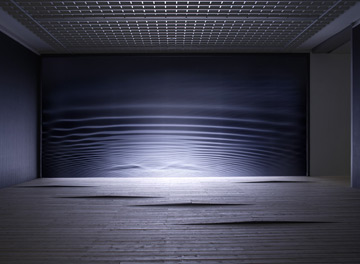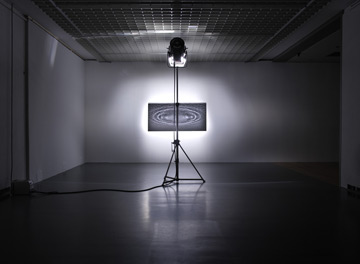If a photograph is the image of an exact moment experienced endlessly, Olafur Eliasson’s installations are the experience of endless image moments. Unlike the camera, which produces a mystery by hiding its role in the production of an image, Eliasson reveals and multiplies the producing elements of his work. As a viewer, one often views a product, while the production, like the camera, is hidden. Eliasson’s work, however, inaugurates a new category of viewing, the viewer/subject. Within this role, the viewer is such as an experiencer, and as an element of production being experienced, is a subject.

Pictures of Iceland’s natural landscapes line the walls. They function as a reminder that a picture is merely a framing of environment. The installations' "cameras" are dismantled. Their parts: light and lens, are scattered so that they are not directed at the subject, but surrounding you, comprising an environment. This conversion allows for the incorporations of the viewer/subject, a third dimension, movement, and the passage of time.
The bridge entrance to the exhibit has been reconstructed into a kaleidoscope. Here the image is created literally like a photograph using light and lens. Later, after the lesson has been repeated throughout the mapped exhibit, the lens is clear glass and mirror, reflecting San Francisco, and the light is natural. The environment is the everyday, both the real and the reflection, both equal image experiences.
As a viewer/subject, the viewer is aware of the producing elements because of their status as a subject. Eliasson hides nothing. The viewer enters “Notion Motion” to find their presence in the room creating waves that are projected onto the screen before them. The screen does not hide the pool of water, spotlights, and projection foil from the viewer, those are viewed from a second entrance to the room where the viewer sees only them, pulling the curtain to reveal Oz.


Eliasson asks that the viewer “take their time.” In contrast with a photograph, which stops time and its subject in their process, Eliasson invites the process to take part, simultaneously initiating the viewer/subject. The viewer/subject shares control with the artist, shaping the experience of the piece, and taking responsibility, taking action, and taking their time, which itself is a producing element, not a force to be overcome.
Sanaz Yamin
Go see it: http://sfmoma.org/exhibitions/exhib_detail.asp?id=232

1 comment:
fantastic.
Post a Comment